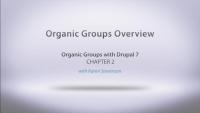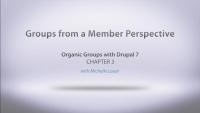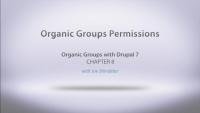This page is archived
We're keeping this page up as a courtesy to folks who may need to refer to old instructions. We don't plan to update this page.
In this video series Karen Stevenson, Michelle Lauer and Joe Shindelar take a look at the Organic Groups module for Drupal 7. The series starts from the basics and goes through the various requried modules used to build a site with Organic Groups and then gets in depth with creating groups, adding content to groups, and dealing with group membership.
In addition to the basics of creating groups the series also takes a look at the various settings related to both access control and permissions and how you can combine them to create private and public groups. How to use the OG Extras module to display more information on the main group page and then how to use the Panels module to display group content and other advanced Fields and Views configuration related to OG.
This video assumes that you understand the basics of content, fields, and Views in Drupal. If you need a refresher on these topics here are some other tutorial series to review:
Note: There have been significant changes to Organic Groups since this lesson was made. We use the 7.x-2.x-dev version from May 2012, or the equivalent of 7.x-2.0-alpha3, in our lessons. Though we would like to revisit this series to update it, we have no current schedule to complete that. The best place to figure out what has changed and why, would be the Organic Groups issue queue on Drupal.org (http://drupal.org/project/issues/search/og).
In this video series Karen Stevenson, Michelle Lauer, and Joe Shindelar take a look at the Organic Groups module for Drupal 7. The series starts from the basics, goes through the various required modules used to build a site with Organic Groups, and then gets in depth with creating groups, adding content to groups, and dealing with group membership. In addition to the basics of creating groups, the series also takes a look at the various settings related to both access control and permissions and how you can combine them to create private and public groups. Next we show you how to use the OG Extras module to display more information on the main group page and then how to use the Panels module to display group content and other advanced Fields and Views configuration related to OG. This video assumes that you understand the basics of content, fields, and Views in Drupal. If you need a refresher on these topics, consider reviewing these other tutorial series:
Note: There have been significant changes to Organic Groups since this lesson was made. We use the 7.x-2.x-dev version from May 2012, or the equivalent of 7.x-2.0-alpha3, in our lessons. Though we would like to revisit and update this series, we have no current schedule to complete that. The best place to figure out what has changed and why, would be the Organic Groups issue queue on Drupal.org (http://drupal.org/project/issues/search/og).
Additional resources
In this presentation Karen walks us through the basic concepts of the Organic Groups 7.2 module, also known as OG. She looks at what OG can do for us, explains how it works in Drupal 7 with entities, and does a brief comparison of OG with a multi-site installation.
Additional resources
In this video Michelle takes a look at our example site, My Town Sports, from a member's perspective. We can review a list of groups, subscribe and unsubscribe, and create content for a group we belong to.
Additional resources
In this video Michelle will give us a tour of our example site from the manager perspective, so we can see how you manage a group. We'll look at the extra administrative rights they have for the group, including accepting new members. We also talk about roles and permissions within a group, and briefly discuss the difference between permissions and access control.
Although the video uses the "dev" version of Organic Groups, there has since been a stable release of the 2.x branch.
Additional resources
In this chapter, Joe Shindelar goes over all the necessary modules needed to get organic groups up and running. He also discusses that there are two methods using two different modules for viewing group information and content.
Additional resources
In this chapter Karen Stevenson explains all the pieces that make up an Organic Group content type. Show explains how organic groups adds the necessary fields to make this happen while demonstrating the necessary settings when building your content types. She also covers the content type used for group content as it is different than the group itself. To start the video off she goes over install the necessary modules for the first part of this series.
Note: There have been significant changes to Organic Groups since this lesson was made. Though we would like to revisit this series to update it, we have no current schedule to complete that. The best place to figure out what has changed and why, would be the Organic Groups issue queue on Drupal.org (http://drupal.org/project/issues/search/og).
Additional resources
In this chapter Karen Stevenson will cover getting some content and users into our site. She will achieve this using the Devel module, with a few tips and tricks because of all the references Organic Groups uses to work its magic. The reason we need this content is so we can understand how all the components of a group work. From a manager to member, and individual content, each has a different role in an Organic Group.
Additional notes:
Around 3:22 a new Announcement was made with Cardinals as a selectable option in the Team field. That option only appears if, as admin, you explicitly join the Cardinals group.
Additional resources
In this lesson, Joe Shindelar goes over all the possible permissions with Organic Groups. He explains the differences between the regular core permissions, and how Organic Groups can override these to give the proper user experience of grouped content. He will show how this affects each role in a group and how to manage those roles.
Note: In Chapter 8 ("Organic Groups Permissions") there are several blocks (Group details, Create content, etc.) and the "groups" tab in the main menu that were not introduced in Chapter 7. These blocks and the new tab are explained in Chapter 10. Sometimes we don't record tutorials in the same order they appear online, which creates discrepancies. This is what happened here—sorry!
Additional resources
In this lesson Joe Shindelar covers all aspects of Organic Groups and access control. He describes how Drupal's access API allows for Organic Groups to function in such a way that certain groups and/or pieces of content can be hidden from users that don't have access to it. He demonstrates how you can add fields to groups and/or content types to have fine control over this access control on an individual basis versus the defaults. He also demonstrates how you can switch this control at any time to give a user access to content they may not have had access to at time of publication.
Additional resources
In this lesson we take the approach of using the Organic Groups Extra module to spruce up our team pages with relevant content. By itself Organic Groups doesn't do a whole lot to display either a useful groups page or the relationships between a piece of content and the group itself. Instead it relies on modules that are geared towards that specific task like Panels or Organic Groups Extras. Joe shows us how we can use OG Extras to make the group page itself a bit more useful by displaying some additional information like a list of group members and the list of all the content that's been posted in that group.
Additional resources
In this lesson Karen will talk about how to use Panels and Panelizer to display group content in various ways. She will first demonstrate how to use the built-in features that come with Organic Groups to construct a basic group and group panel. She explains how this can be done using the features module. She then demonstrates using the new Panelizer module to create a system where every group can have its own layout and content. Note: Karen enabled the Features module then separately enabled the OG Example feature, which has a dependency on Panels and other modules so basically Features enabled them. If you actually enable that feature on the modules page it will tell you that panels is required and asks to install it. Karen however enabled the Panels modules via the Features admin page.
Additional resources
In this lesson we cover a module that comes with Organic Groups called "Organic Groups Context". We cover why this module exists, how it helps build out your groups page, and the way it lends a helping hand building out views to make your Organic Groups that much more powerful.
Note: You must first be a member of the organic group referenced by the node for filtering to work. Under relationships, we've selected "OG membership: OG membership" from Node. So if you're not a member of the group referenced by the node, you will get zero results.
Additional resources
In this lesson we give a tour of some of the views that Organic Groups and Organic Groups Extra created and are using. We give a brief understanding of how all the references and relationships can make Organic Groups a confusing thing to grasp.
Additional resources
In this lesson Karen will go into more detail about how the Entity Reference and other group and reference fields work in Organic Groups. She will show how you can add more fields to the membership and display them in Views. Karen will also illustrate how to create additional membership types, like a membership that is intended to be temporary rather than permanent.
Note: This video was recorded using older versions of some of the modules. At the time there where 2 different og_reference* fields that you needed to handle. og_reference and og_group_ref_other_groups_ref, in current versions of the modules used there is just one og_reference field.













